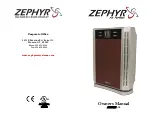
Page 14
Charging Using Normal Operating Pressures
and the Approach Method
TXV Systems – Outdoor Temp. > 65
F (18
C)
The following procedure is intended as a general guide and
is for use on expansion valve systems only. For best results,
indoor temperature should be 70°F (21°C) to 80°F (26°C).
Monitor system pressures while charging.
1 − Record outdoor ambient temperature using a digital
thermometer.
2 − Attach high pressure gauge set and operate unit for
several minutes to allow system pressures to stabilize.
3 − Compare stabilized pressures with those provided in
table 5, Normal Operating Pressures." Minor varia-
tions in these pressures may be expected due to differ-
ences in installations. Significant differences could
mean that the system is not properly charged or that a
problem exists with some component in the system.
Pressures higher than those listed indicate that the
system is overcharged. Pressures lower than those
listed indicate that the system is undercharged. Verify
adjusted charge using the approach method.
Approach Method
4 − Use the same digital thermometer you used to check
the outdoor ambient temperature to check the liquid
line temperature.
5 − The difference between the ambient and liquid temper-
atures should match values given in table 4. If the val-
ues don’t agree with the those in table 4, add refriger-
ant to lower the approach temperature, or recover re-
frigerant from the system to increase the approach
temperature.
Table 4
Approach Values
Model Number
Liquid Temp. Minus Ambient
Temp. °F (°C)
HS27−024
5 + 1 ( 3 + .5)
HS27−030
5 + 1 ( 3 + .5)
HS27−036
6 + 1 ( 3.3 + .5)
HS27−042
7 + 1 ( 3.9 + .5)
NOTE − For best results, the same digital thermometer should be
used to check both outdoor ambient and liquid temperatures.
IMPORTANT
Use table 5 to perform maintenance checks. Table 5
is not a procedure for charging the system. Minor
variations in these pressures may be due to differ-
ences in installations. Significant deviations could
mean that the system is not properly charged or that
a problem exists with some component in the system.
See table 5.
Table 5
Normal Operating Pressure
s
Outdoor
HS27−024
HS27−030
HS27−036
HS27−042
Outdoor
Temp. (
F)
Liq. + 10
psig
Suct. + 5
psig
Liq. + 10
psig
Suct. + 5
psig
Liq. + 10
psig
Suct. + 5
psig
Liq. + 10
psig
Suct. + 5
psig
65
135
78
139
79
136
76
141
82
75
159
79
163
80
160
77
166
82
85
186
80
180
81
188
80
185
82
95
216
82
219
83
217
80
226
85
105
249
83
252
84
251
82
257
85


































